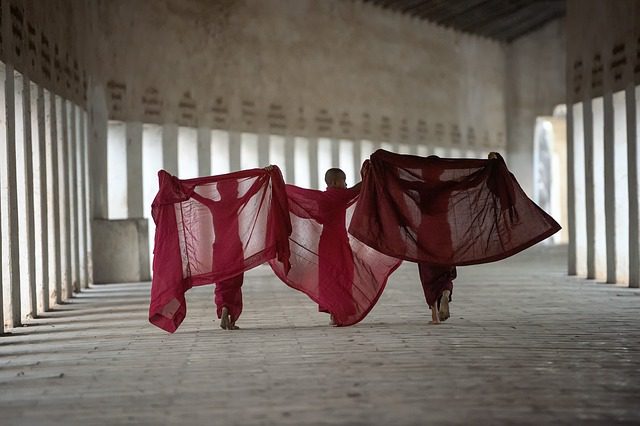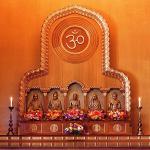Even before the #metoo movement went viral last month, a bombshell – or at least a hand grenade – had dropped in the Western Tibetan Buddhist world. In July, 8 former students of Sogyal Lakar (or ‘Rinpoche’ to devotees, famed author of The Tibetan Book of Living and Dying) co-signed a letter outlining his years of sexual, verbal, and physical abuse. In response, Lakar stepped down, leaving over 100 Rigpa centers that had been under his direction in limbo.
At virtually the same time, Lama Rod Owens, co-author of Radical Dharma: Talking Race, Love, and Liberation, and one of the emerging voices of 21st century American Buddhism, wrote a powerful facebook post (reproduced and discussed here) about discovering that his teacher, Norlha Rinpoche, had abused women followers as well.
Western fascination with Buddhism
For the last sixty-plus years, as Buddhism boomed in the Western world, it developed (mostly) a mystique of all pervasive goodness. In his 1998 book, Prisoners of Shangri-La: Tibetan Buddhism and the West, professor Donald S. Lopez writes:
Tibet and Tibetan Buddhism have long been objects of Western fantasy. Since the earliest encounters of Venetian travelers and Catholic missionaries with Tibetan monks at the Mongol court, tales of the mysteries of their mountain homeland and the magic of their strange-yet strangely familiar religion have had a peculiar hold on the Western imagination. During the last two centuries, the valuation of Tibetan society and, particularly, its religion, has fluctuated wildly. Tibetan Buddhism has been portrayed sometimes as the most corrupt deviation from the Buddha’s true dharma, sometimes as its most direct descendant. These fluctuations have occurred over the course of this century, at its beginning as Tibet resisted the colonial ambitions of a European power and at its end as it succumbed to the colonial ambitions of an Asian power.
The emergence of the current Dalai Lama, with his broad smile and persistent giggle, tilted perceptions strongly toward the positive. It didn’t hurt that he was a refugee of that well-known evil, Maoist Communism, spreading a message of kindness, world peace, and a pro-scientific turn in Buddhism to football stadiums filled with Westerners who had grown tired of both their own religions and capitalism-fueled hedonism. He offered, for those who wished to dig in, a middle way: neither scornfully judgmental of pleasure but also teaching moral responsibility and mental discipline. Those who remained as detractors of Tibetan Buddhism, such as then-Cardinal Ratzinger, were a distinctive minority.
But along with the Dalai Lama came countless other refugees of the red scare: fellow Tibetans, Indian/Hindu teachers, Thich Nhat Hanh from Vietnam, and on, fulfilling many Westerner’s romantic needs for an idealized “other”. While the Dalai Lama has been widely loved in the Western world (he did cause ripples and need to change/clarify his views regarding homosexuality in the late 90s and after), several Tibetan Buddhists – both those from Tibet and Western converts who have risen to the status of teacher – have been at the heart of scandals.
Several of these are documented in Anna Sawerthal’s timely article, “Abuse and Buddhism: Behind the Smiling Façade.” One of those was a “Belgian man named Robert S., who dressed in Tibetan monk’s robes and took up a new name in 1972: Lama Ogyen Kunzang Dorje,” who founded a community called Nyima Dzong where he allegedly repeatedly abused young girls.
In Nyima Dzong, people were indoctrinated to see everything in a positive light. Negative thoughts were said to be signs of a clouded mind. Only Robert S. allegedly had access to ‘true reality’. He quoted Tibetan teachers with whom he had supposedly studied in India. And various Tibetan teachers made him seem legitimate by visiting the OKC over the years, for example the Dalai Lama in 1990. By that time, many instances of sexual abuse had apparently already occurred.
Sawerthal continues, saying that this is not an isolated case.
One might think that allegations surrounding OKC constitute a horrible exception, a monument to the failure of entire institutions: family, friends, or the justice system. However, the OKC is unfortunately only an extreme example of a larger problem that has gone essentially unnoticed: abuse in the name of Buddhism. Just off the top of his head, Tenzin Peljor can name nine recent cases in Europe. Born in Germany as Michael Jäckel, Peljor became a Tibetan Buddhist monk in 1998. He says that he initially ended up in a Buddhist cult himself. After a four-year struggle to get out, he has since dedicated himself to promoting an open discussion about similar problems in other Buddhist communities. Three of the groups he can point to are in Germany.
Rob Hogendoorn, a Dutch publicist and long-time Buddhist, is currently following some twenty cases in which Buddhist teachers in the Netherlands have been accused of sexually abusing their students. The country has 39 recognised Buddhist organisations; he claims to have received complaints about almost half of them. (Abuse and Buddhism)
Some of my background
My own exposure to questionable and/or troubled groups is similar. I first started practicing and studying with ordained members of the FWBO (now TBO), which had weathered ongoing controversies around their leader, Sangharakshita’s, unorthodox sexual teachings and allegations of abuse. Though I didn’t experience any problems directly, having seen the allegations and ongoing controversies regarding the lack of resolution, I decided to keep my distance. I later stumbled across “Geshe” Michael Roach online and spent months absorbing his teachings on Tibetan Buddhism, even traveling with friends from the UK to Ireland in 2005 when he taught there, and later spending time with his students in Arizona when the Dalai Lama visited the same year. Similarly, while my experiences of him and his students were generally good, I found web resources pointing out flaws in Roach’s behavior and his background that gave me enough reason to step away from his teachings. While in the UK, I dropped in on a “New Kadampa” center for a teaching, but never went beyond that. One of the most-visited pages on this blog is a 2011 post discussing the New Kadampa tradition and the “survivors group” that formed to help ex-members reintegrate into society.
These and other experiences have led me to be quite weary of Buddhist groups (Tibetan and others, Zen has not been without scandals in recent years and at least a couple cases of teacher misconduct have arisen in Theravadin communities). Yet it would not be fair to suggest that all, or even a majority of Buddhist groups have abusive leadership.
How big is the problem?
One major investigation in Australia’s Catholic Church found that 7% of Priests sexually abused children in the past. In the Boston Globe investigation in the early 2000s, dramatized in the movie Spotlight, the same number was given. There is no reason to believe the problem is Catholicism’s alone; several studies show an equal if not larger problem in Protestant Christianity and organizations such as An Olive Branch suggest that this is no less a problem in Buddhism. Predators will be drawn to positions of power.
This is a low number if you are a gambling person walking into any given Buddhist center. However, when you consider the thousands of Buddhist teachers spread across the West, 7% means that there are likely hundreds who have used or continue to use their positions of authority to abuse students.
Buddhist scholar Bernard Faure recounts several of the scandals of Western Buddhism in his book on Buddhist sexuality, The Red Thread, but then warns us, “The problem is by no means limited to Western interpretations of Mahāyāna: it is also found in Asian forms of Mahāyāna and Theravāda… [F]ar from being mere accidents due to individual personalities, [the scandals] may also be seen as structural problems, having deeper social, psychological, and cultural roots. These behaviors found some doctrinal justification in the teachings of Mahāyāna or Great Vehicle— particularly in its most radical versions,Vajrayāna and Chan/Zen.”

What Next?
The current debate has been framed at times as one of a clash of cultures and value sets. The Dalai Lama gave the analogy of the French Revolution, saying sometimes religious institutions become “frankly, rotten” and that it’s therefore worthwhile to be against them. Speaking of Sogyal, he said that he is a disgrace who has used “religion as an instrument for exploitation.” The Dalai Lama spoke out earlier about Sogyal as well, urging students to publicize any misconduct by a teacher by whatever means they can.
Lama Rod Owens and Justin Von Bujdoss (Repa Dorje Odzer) spoke publicly in August, drawing connections between the patriarchy and abuse in Tibetan Buddhism and the events in Charlottesville.
On the other hand, Dzongsar Khyentse Norbu, a Bhutanese Buddhist teacher and movie maker, used the accusations against Sogyal Lakar as an opportunity to lambast Western media and values and question the intelligence of the accusers. He went on to praise so-called “crazy wisdom” methods of teaching employed by Tilopa, Chogyam Trungpa, and Sogyal Lakar. However, scholars and long-time practitioners of Vajrayana debate the appropriateness of “crazy wisdom” as a term used for sexual predation by teachers. And as he draws Lakar and Trungpa together, it is worth noting the other side of their actions, likened by some to a dysfunctional family:
Oane [one of Lakar’s former students] sums up the Rigpa’s inner circle with a bitter comparison: “It is like a dysfunctional, incestuous family with grave sado-masochistic tendencies, but without a safeword.” (Abuse and Buddhism)
and:
I found especially interesting the dynamics between the Tibetan lama, Trungpa Rinpoche, and his American students, all brimming with devotion and lacking in personal authority, and the parallel with dysfunctional family systems. Trungpa Rinpoche appears as a drunken, crazy surrogate for the dysfunctional families of the authors. The ploys used to keep the power differential operating in the community of Rinpoche’s followers mimic the betrayal and required secrets in the alcoholic family. (from here)
Of course, to some followers, all of this could be perfectly true and it could still be the expression of a perfectly enlightened being.
This is perhaps one of the most frustrating aspects of contemporary Tibetan Buddhism. And it does seem to be squarely at odds with Western culture, perhaps not the culture of the 1960s Catholic Church or other secretive patriarchal institutions, but rather with the growing culture of openness and gender inclusivity.
The Dalai Lama has embraced the fight for greater inclusivity, the Karmapa as well, as have a growing number of younger teachers, including many women. It is not clear to me what we might lose by giving up patriarchy and secrecy, but I think we gain immensely by listening honestly to victims, removing shrouds of secrecy, and punishing the men who have used the Dharma “as an instrument for exploitation” (to quote the Dalai Lama).
Just how this fight plays out will go a great distance toward shaping the future of Tibetan (and other) Buddhism in the world.
Support independent coverage of Buddhism by joining a community of fellow learners/practitioners at Patreon.
‘Like’ American Buddhist Perspectives on facebook.












